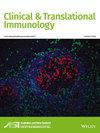Lack of immunogenicity for an influenza-derived peptide across the HLA-B44 supertype molecules
Abstract
Objectives
CD8+ T cells are protective against influenza and there is an interest in designing a future CD8+ T-cell-mediated vaccine. However, a significant challenge is the extensive polymorphism of Human Leukocyte Antigen class I (HLA-I) molecules, the targets of CD8+ T cells. Despite this, HLA supertypes have been defined as a subset of HLA-I molecules sharing similar peptide motif preferences that may present overlapping peptide repertoires. Therefore, selecting immunogenic peptides presented by a range of HLA-I molecules for inclusion in a vaccine may partially overcome the challenge presented by HLA-I polymorphism.
Methods
In this study, we investigated the presentation and immunogenicity of a known HLA-B*44:03-restricted influenza-derived peptide NS1195-203 across the HLA-B44 supertype. Using TFold and AlphaFold2, we predicted the structures of the NS1195-203 bound by the HLA-B44 supertype molecules, including HLA-B*44:02, HLA-B*44:03, HLA-B*40:01, HLA-B*40:01 and HLA-B*45:01. Peripheral blood mononuclear cells (PBMCs) isolated from donors expressing one of these HLA-B44 supertype molecules were used to generate CD8+ T-cell lines against the NS1195-203 peptide and assess its immunogenicity via intracellular cytokine staining assay.
Results
The structures predicted with TFold and AlphaFold2 of the NS1195-203 peptide in complex with the HLA-B44 allomorphs were overall similar, with some notable differences at the peptide P9-Trp. A polyfunctional NS1195-203-specific CD8+ T-cell response was observed in HLA-B*44:03+ and HLA-B*44:02+ samples; however, minimal responses were observed in the three other HLA-B44+ supertype molecules.
Conclusion
Although HLA molecules from the same supertype may be able to present the same peptide, this will not always result in CD8+ T-cell responses. As such, HLA-I supertypes, defined based on peptide binding motif and presentation, do not include information on immunogenicity and are not currently able to be used on their own to select epitopes as vaccine candidates. However, new knowledge on HLA supertypes may help curate sets of peptides that are potential vaccine targets and applicable to a range of HLA allomorphs.


 求助内容:
求助内容: 应助结果提醒方式:
应助结果提醒方式:


